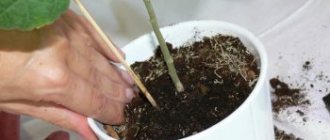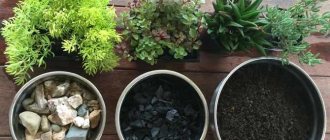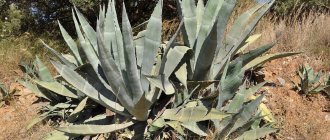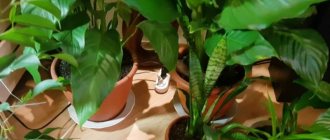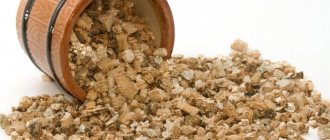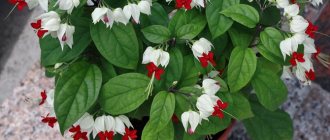Pandanus flower is one of the most exotic plants. At the same time, its distinctive features are unpretentiousness and absolute non-capriciousness. An undeservedly forgotten culture. Even in the last century, tubs with a beautiful palm-shaped crown stood in the homes of many wealthy people, decorating winter gardens, country residences, and holiday homes.
Now indoor pandanus is a rare guest in modern homes. Gradually, the fashion for such plants, which add a special chic to the interior, is returning again.
Euphorbia milli
This tropical succulent from the Euphorbiaceae family takes root well in city apartments. Its charming appearance is given by its flowering, which lasts all year round. The inflorescences themselves are inconspicuous, like most euphorbias, but the real decoration is the colorful, bracted leaves.
Due to its unpretentiousness, the plant does not require constant attention. The main thing in growing a flower is the formation of the crown. This is achieved by pruning the lower branches in early spring. Removing old branches will help maintain the optimal size of the plant and stimulate its flowering.
The danger of Euphorbia Milli lies in the toxicity of the flower. The milky sap of the plant contains caustic substances, contact with which causes poisoning or skin burns. And if it accidentally gets into the eyes, it causes temporary blindness.
Hibiscus
An incredibly beautiful tree-like shrub, growing up to 3 meters in height, has more than 200 species and varieties. The plant has lush foliage of a lush green hue. In the wild, hibiscus blooms with luxurious large buds resembling cups almost all year round, but at home flowering continues only from spring to autumn. But even without flowers, its decorative effect does not suffer - the tree looks impressive.
Like any tropical plant, hibiscus prefers bright light, high humidity and abundant watering. The only negative is the very slow growth of the plant. It will take more than one year for a young seedling to begin producing buds every year and delighting its owner.
Prickly...but so beautiful!
My love for cacti began with a gift, and this gift was given by my mother’s friend.
On New Year's Eve I was given a small tray, and in it, in yogurt cups, were small cacti! I don’t remember exactly how many there were, probably 6. These were tiny babies separated from an adult plant. Well, from that moment it began! My babies settled in well, then moved to larger pots. And I started buying new copies. I really love them!))) So I’ll introduce you to my not very large, but for me very valuable collection! Without him - nowhere! The most traditional, the most common, my thorn is Echinopsis. I have him still a little one, you might say, compared to what they are like. But, despite the small growth, it pleases with flowering! In late spring or early summer, 1-2 buds appear on it, reminiscent of a willow. They develop very slowly. At this time, I generally try not to touch or move the cactus. Well, the result is such beauty! A flower on a long flower tube of 20 cm, with a diameter of 10 cm, blooms literally in 2-3 hours, before our eyes. It's a pleasure to watch. It has a delicate pink hue and exudes a delicate aroma. Indescribable beauty! It’s a pity that it doesn’t last long, 2 days maximum. The peculiarity of caring for Echinopsis is that it loves nutritious soil, to which I add humus. The dishes for him are more spacious than for the others, I water them often and abundantly during the growth period, and of course I feed them. In winter, like everyone else, there is a period of rest.
Next up is my little Mammillaria Gracilis! Very easy to care for, it blooms almost all year round for me, with only a respite for a couple of months in the winter. It grows quickly and forms a bush like this, completely covered with flowers in the spring. I use special soil for cacti; it doesn’t need a large pot at all; in spring and summer, I water it once a month with mineral fertilizer for cacti.
Mammillaria Prolifera grows in a large bush and is completely covered with cream flowers in the spring. This is my smallest one). Getting ready to bloom, they're about to bloom.
And this is Mammillaria Haniana , I’ve had it recently, about 1 year, but I’m already pleased with it; it bloomed in the spring, all covered with bright purple flowers.
And another mammillaria
My giant Rocky Cereus, as they say in the books, is the result of a natural anomaly associated with a violation of normal growth. In order for it to truly grow into a giant, it must be planted in a spacious pot with a good nutrient mixture, less sand and more earth, humus (but poorly rotted organic matter is dangerous for it). I have it in a sunny place, I water it abundantly in the summer, and keep it dry and cool in the winter. And it is very important to periodically treat against pests for prevention. It is also easily propagated by cuttings. and a slightly smaller copy...
And a simple cereus, not very big yet
You can say my pearl is Echinocactus Gruzoni! Everything about him is super-cactus-like: the stem is spherical, bright green, large areole pads and very impressive powerful, slightly curved spines. The story with him was not easy) I bought 2 small specimens, 3-4 centimeters in diameter, but they did not take root with me. The third time I bought it on sale, a discounted copy, which had lost its beautiful appearance, on the verge of destruction, so to speak) I thought, I’ll try again and if it doesn’t work out, then I won’t do it again. And he, as they say, to spite his enemies, survived and continues to grow, now he has grown to such a size, 15 cm in diameter. But it must be said that he is growing slowly. It needs “typical cactus” care, hot summers with bright lighting, cool dry winters. I do not add humus to the soil. Sometimes I spray it to wash the dust off it). He doesn’t need large dishes either.
And this is Ferocactus , a handsome one, bluish in color with long spines. It’s a pity that it grows very slowly; it generally blooms in indoor conditions, but mine, apparently, has not yet matured. I don’t add organic matter to the soil for it, it also needs good drainage, I water it very carefully.
My handsome Espostoa Lanata , majestic, reminds me of an old man). Unfortunately, it also grows quite slowly. Initially there was one stem, after 1.5 years, 2 more grew from the root. It has been growing for me for about 7 years now. It really needs bright, good lighting (it is a mountain dweller after all). I make the soil for it loose, with good drainage, without organic matter. In winter it stays dormant for about three months; I don’t water it at all. In summer, watering is also careful, it is better not to add water.
I've been looking for this guy's name for a long time) Myrtillocactus geometrisans! It stretches into a large column, a very impressive bluish-green color, grows by 3-4 cm per year, and each growth is visible and differs in color. I plan to plant several specimens in one pot.
Another columnar cactus, Stetsonia corine , has already reached a respectable size. Loves spacious dishes and a lot of light. Its spines are the most “cactus-like”, as they show in cartoons, 6-7 cm long.
And another one - Hageocereus , very cute and growing quickly. But he needs the brightest lighting and warmth, otherwise he begins to stretch out and turn pale. I had 2 of them and they didn’t want to branch, they grew in one column and that’s it. I decided to try cutting one, cut it about 2/3, slightly sharpened the cut part and placed it in a vertical position, after 1.5-2 months the roots began to appear and I rooted it in the ground. And on the adult specimen there were 3 side shoots, I left them like that.
Another one of the cereus, but I didn’t find the exact name for it.
I love prickly pears, but, unfortunately, I only have two Opuntia microdasis, with yellow needles, and the other with brown ones (bought recently, so it’s still small). My prickly pear is a little over a year old, it grew from one segment, so it is growing quite quickly. I make the soil for it with sand and good drainage. In general, it is very unpretentious; a beautiful bush quickly forms. But I must say it is dangerous for animals and small children, the spines are very small and fall off, if they get on the skin, it is very difficult to get them out. I once read how the Indians deal with this: they drop melted wax onto the place where the thorn got into, it hardens and comes off along with the thorn. The method works, I checked it!
Of the epiphytes, I have a couple of Schlumberger, one scarlet, the other pink, but unfortunately I did not have time to photograph them in bloom. What I like about them is how easy they are to care for, the most important thing is to water and spray. Water deeply from the appearance of buds until the end of flowering. They also reproduce well, a couple of branches broke off, I put them in water, a week later roots appeared and I immediately put them in the ground. Prefers a bright, but not sunny place.
Well, an as yet unidentified object)))
In general, I try to use special soil for cacti for everyone. Only for Echinopsis and Cereus do I make nutritious soil with humus. Since October I have been reducing watering for everyone, and since December I have not been watering at all. I start watering gradually in March, and in May I start using mineral fertilizer. Well, I treat it with fungicides for prevention. And if something happens to one of the specimens, I try to separate the healthy part and root it. Rooting, as it turned out, is also very simple for everyone. We separate the children or part of the stem and leave until the roots appear. Some do not sprout roots quickly, for example, cereus, it can take a month or two. I either place the cuttings vertically (for example, if the cutting is wide in diameter, I put it in a yogurt cup, it looks like it’s suspended), or I simply leave it lying in partial shade. I also have other pets)))
I recently got Zamioculcas The optimal lighting for it is bright diffused light or partial shade. I water it carefully, when the soil is already dry, the main thing is not to overwater it.
My Ficus Benjamina has been growing for quite some time now, but it is not growing very quickly. Loves spraying, but watering is moderate.
The fern grows very quickly and pleases with its appearance. I understood one thing: he doesn’t need a big pot. For a long time it grew in a large pot, or rather, it did not grow at all). Then I transplanted it into wide and not deep pots. And here is the result. I water it often and spray it often.
Euphorbia is capricious, almost like cacti) I water it carefully so as not to flood it; in winter there is a relative period of rest. I wipe the leaves. It happens that in the fall it can shed its leaves, not all of them, of course, but a lot. Easily propagated by seeds (which it scatters abundantly around itself). The one on the left is actually from a seed.
There is also yucca, but it is a slightly different species than we are used to seeing. Because I didn’t trim it, now it’s about 2 m tall and I like it better this way)
This is my home garden!
Indoor rose
A miniature indoor rose bush in a cute pot is the dream of many plant growers. Colorful buds with a delicate scent and thin graceful shoots will not leave anyone indifferent. But this flower is known for its capricious and finicky disposition, so when breeding it you will have to be patient.
Caring for the plant is not easy. As in natural conditions, it must be sent to a cold room for wintering. And in the summer, indoor roses do not tolerate hot and dry weather well, so it is advisable to take the flower out into the open. It is important to avoid direct sunlight. The plant can simply burn out with prolonged exposure to ultraviolet radiation.
Method of propagation by cuttings
The rooting process occurs quite quickly. This is done in water or special mineral solutions such as sphagnum or vermiculite. Then the cuttings are dried for several days, and if they are large, for a whole week, and planted in moist, prepared soil. The first signs of growth after rooting may not appear very soon. Sometimes it can even take about a year. There are also situations when the cuttings fall off on their own and can take root and begin to sprout right in the pot near the main flower.
Philodendron
The perennial evergreen “guest” from the South American tropics is used for landscaping the window sills of apartments and office buildings. Philodendron is on the list of flowers that have a beneficial effect on the indoor microclimate. Substances with phytoncidal properties released into the air cleanse it of heavy impurities and harmful chemical elements.
The plant loves bright, diffused lighting, moderately moist soil, and a warm climate with a room temperature of +15...+25°C. It reacts negatively to dry air, so you should spray the flower with warm, settled water 2 times a week.
Diseases, pests and problems
At times, Hatiora is affected by late blight and fusarium.
Late blight . It occurs from improper, too much watering, when water stagnates in the pot, when the watering water is cold. The cactus begins to wither and turn pale. If the disease has not developed greatly, treatment and watering with various available fungicides will help.
Fusarium . Penetrates into the plant through wounds and pest bites. Most often it affects the root collar. The affected area should be cleaned down to healthy tissue and treated with fungicides and copper preparations.
Bacterial infection . Wet, slippery spots appear on young segments. If their distribution is small, you need to remove the infected branches, but it is better not to risk it and cut a new plant from healthy segments.
Araucaria indoors
An unusually beautiful heat-loving coniferous plant will create an atmosphere of freshness and peace in the house, returning the emotional state to a positive direction. This flower secretes special phytoncides that have high antimicrobial activity. This is very useful for frequent colds and problems with the respiratory system.
Araucaria grows in the shape of a regular pyramid, for which it received its second name - indoor spruce. The plant does not require any particularly difficult conditions. It is only necessary to maintain a temperature of +22°C in summer, and +15°C in winter. It is also important to regularly ventilate the room where araucaria grows. If possible, it is better to take it out into the fresh air.
Cryptomeria indoors
Cryptomeria indoors or Japanese cedar is a fragrant, compact-sized conifer that fits in the house and can easily replace a Christmas tree. This evergreen tree has a lush pyramid-shaped crown, and dark green needles with a bluish tint give it a decorative appeal. If you touch the needles with your hands, the air around you is immediately filled with a fresh pine aroma.
This tree is ideal for those gardeners whose home is always cool. Perhaps the only disadvantage of cryptomeria is intolerance to high temperatures. The maximum value on the thermometer should be no more than +12...+16°C at any time of the year. It is equally important to provide the indoor cedar with diffused lighting. Then the tree will retain its rich color and lush shape for a long time.
Kalanchoe laciniata
Due to its original appearance, Kalanchoe laciniata received the name “deer horns”. Its branched carved leaves of light green color are especially attractive to lovers of exotic plants.
This plant is a type of succulent that stores a record amount of water in its leaves and can go without watering for a long time. It will not cause problems during transplantation and propagation. Kalanchoe grows quickly and adapts well at home. Like any tropical guest, it loves bright lighting, so there will be no difficulties with placing a flower pot. You just need to exclude window sills on the north side.
Species diversity
To date, 8 species of this plant have been identified, of which only three or four can be used in home floriculture.
Hatiora salicornioide
Without a doubt, the most popular "domesticated" species. It would not be a mistake to say that 9 out of 10 indoor hatiors will turn out to be its representatives. It is distinguished from all other species by round segments and yellow flowers. The segments that form the crown are about 3-5 cm long and 0.5-1 cm in diameter. Now there are varieties with orange and salmon-colored flowers. This popular species is widely known by another name - Hatiora salina.
Hatiora herminiae
The segments in cross-section are predominantly cylindrical, thinner than those of the previous species. The stems are thin, drooping, requiring additional support. It is distinguished by large, up to 2 cm, crimson-colored flowers.
Hatiora rosea
It has flat segments up to 2.5 cm long. The flowers are very beautiful, large, with pinkish petals and a crimson central cup.
